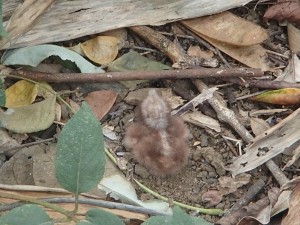The “pocoyo,” or Common Pauraque, is a kind of nightjar familiar to anyone who has driven along Nicaragua’s dirt roads in the dark and seen the reflection of reddish-orange eyes in their car’s headlights as the bird squats on the roadside waiting to catch insect prey.
Like many of Nicaragua’s common birds, the pocoyo has some remarkable characteristics. Its coloring doesn’t seem noteworthy, but in daytime it turns into highly effective camouflage, which is necessary because the pocoyo roosts on the ground. The bird chooses a scrubby area with plenty of dead leaves and branches to merge into the background while it sits rigidly still (second photo). The bird will only take flight if approached, and when it does it appears almost like a large moth.
The pocoyo has a larger relative, the potoo, which also found in Nicaragua but less common and difficult to see. In contrast to the pocoyo, the potoo sits on a tree to roost in daytime, often exposed completely. But its camouflage trick is different. It has similar coloring, but it adopts an upright stance, beak pointing upwards, and is indistinguishable from the broken stub of a tree branch when it sits motionless.
Neither species makes nests, but the potoo rears its young in the crevice of a tree. The pocoyo, meanwhile, simply lays its eggs on the ground and its chicks sit motionless, blending into the background almost as well as their mother (third photo).
The camouflage is most effective when the mother covers the eggs or chicks with leaves. From above, even at very close range, the mother is indistinguishable from the dead leaves and twigs that surround her. If a predator approaches, the mother bird remains motionless until the last possible moment, when she’ll move to distract attention from the eggs or chicks. But most predators never see the hidden birds.
The abundance of these birds (heard, if not seen, at night time when they make their attractive, plaintive calls), shows that the mothers’ strategy works. As more and more dirt roads get paved over, let’s hope the pocoyo can adapt to their new surroundings.
Original post and comments: Nicaragua Dispatch




 John Perry lives in Masaya, Nicaragua where he works on
John Perry lives in Masaya, Nicaragua where he works on
Excellent photo of mother and chick.
Saw the Common Potoo (Nyctibius griseus) in Masaya National Park in Nicaragua in August 2010. It was during the daytime and it was sleeping on a branch of a tree a third of the way down Los Coyotes Trail.
Amazing disruptive coloration makes this species a true master of disguise.